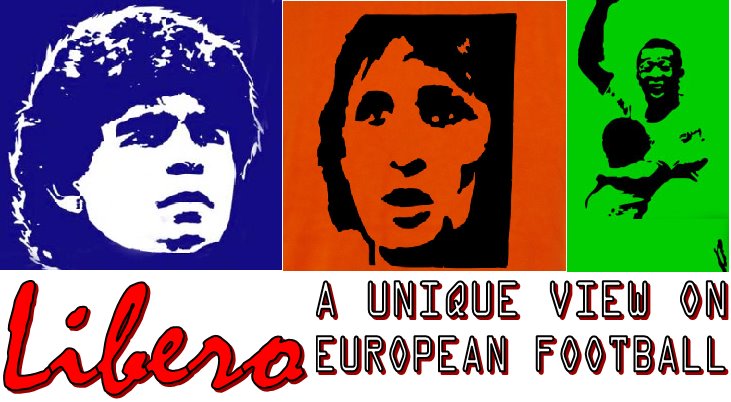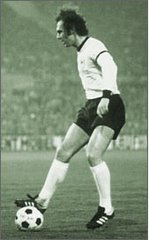As time passes, the general playing style of the game has changed, from new tactical systems, to individual excellence. For example the most lamented moment in the history of Brazilian football, the 1950 defeat to Uruguay, is blamed upon many factors, but most decide upon Uruguay’s decision not to play the WM formation, thought up by Arsenal revolutionary Herbert Chapman, which was adopted by the teams Brazil deposed of in the earlier rounds. In similar fashion, the way in which strikers play and how they are used has changed throughout the various generations affecting the history of the game, choosing the winners and losers.
When one thinks of the targetman they immediately think of the stereotype of the big, strong centre forward, who is efficient in holding up the ball, effective in winning the aerial battle during those cold winter nights in the northern parts of England. The stereotypical image is that of Jan Koller, or recently Didier Drogba. The new type of targetman does not have to resort to use of the elbow, as Alan Shearer and Duncan Ferguson to gain an advantage in challenging for the aerial ball. Instead, as football has progressed, so has the physical fitness and build of the players, with players that exceed the norm, from Crouch to Zigic. Now, even strikers, which have an intimidating build, prefer to play the ball on the ground, with a finer first touch, releasing better through balls, rather than chase hopeful clearances from the first-third of the pitch. The new model of the target man is one with a plethora of qualities, which include pace, skill, awareness and a necessary selfish streak.
There are also unorthodox strikers, with Francesco Totti, who is currently the holder of the golden shoe, the award for the most lethal marksman in Europe. Totti, who is normally a playmaker, took on the role, and operated much higher up the field of play, where his contributions were more efficient, with his clever movement allowing team-mates to take supporting runs from deep in a fluid tactical system. In a similar fashion Thierry Henry played this kind of role in the 2005/06 Champions League run, as a lone front man, moving to either flank allowing midfield runners Fabregas, Reyes and Ljungberg to make penetrative runs wreaking havoc to the opposition, as well has scoring a few goals b exploiting the space created by the movement.
The poacher is a tag given to players who have good movement in the box and therefore tend to score more often, due to composure in tight spaces and seemingly difficult situations, and a ‘sixth sense’ for where the net is. The player which epitomises this generalisation is Gerd Müller, who scored goals of any kind, perfecting his movement in the box, twisting and turning to approach each possible situation with the maximum possibility that he would have a clear-cut chance and that that the most possible outcome would be the scoreboard reading his name. As the game has gone on, the use for pure goal-scorers has diminished as Ruud van Nistlerooy discovered when he was ruthlessly dropped mid-season by Sir Alex Ferguson in the 2005/06 season in favour of the more all-rounded Louis Saha. As the game progresses in terms of speed, players must have greater qualities and such gems are more difficult to find even with thorough scouting systems. For example, players such as Samuel Eto’o have great pace, strength and stamina make him the first line of defence for Barcelona, and allow his team to press the opposition high up the field, and along with his fellow forwards, Ronaldinho and Messi, and the interplay allows fluid change of positions, lets him use his goal-scoring talents to the full extent as his 73 goals in 115 appearances for Los Cules shows. Arsenal’s recent acquisition of Eduardo da Silva, who rather has the same instinct in front of goal, but can also dribble, pass and hold up the ball shows that not only a ‘poacher’ is now required as the failed gamble on Francis Jeffers proved. On the other hand in a team with a mindset as defensive as Helenio Herrera’s perfection of the catenaccio displayed through his Inter Milan side in the 1960’s, van Nistlerooy has been feeding off scraps, scoring a goal for every 2.3 shots he had, shows that on rare occasions, players can rely on pure instinct.
The shadow striker or half-striker is the name given to the player who drops in between the attacking and midfield lines to find space and create advantageous plays for his team. Naturally, one must be gifted to operate in this kind of role, which is rarely adopted in English football, where use of a defensive midfielder is the norm, who picks up any midfield runners, or playmakers. After Hidegkuti’s revolutionary creation of this position, coaches have created new roles or different formations for their players in order to inhibit the half-striker, from man marking, sometimes disciplined, sometimes, through collective fouling in a simultaneous fashion with each player committing a foul, a pastime in Italy. As I have suggested in a previous article, Genius is normally positioned in this role, free to move between lines, affecting the play as one sees fit. These players have lesser goal-scoring records from an aesthetic point of view, but looking at the assist and involvement in moves leading up to a goal, they normally lead the charts.
Therefore players with vision such as Dennis Bergkamp used the few seconds bought by the extra space to use his vision and pick out a player. The understanding formed between him and his fellow attackers was built either on hard work in training or natural instinct and 360 degrees awareness on movement of his team-mates, through constant turning and twisting of his head to see progression of play. This was highlighted in a quick counterattack by Arsenal in the 2003/04 season at Chelsea, where high pressing forced an error from Makelele, and immediately after Bergkamp had possession and after a look, used his experience and decision-making skills to pick the best option within a few seconds and released Vieira with a wonderful curling pass from the outside of the foot right into the Frenchman’s stride, allowing him to slot home with ease. A wise man did once say the best players have one or two touches on the ball a thousand times during a game. Hidegkuti also used his more direct strike partner Puskas, to run in behind the defence and pull the centre backs away from him, and create space, which he used to take shots on goal.
Most teams use a proven blue-print with a number of players complementing each other in their strike force. Take a look at Arsenal’s options, where no one player is the same, with different attributes, van Persie offers elegance and technical excellence, Eduardo offers a clinical edge, Adebayor offers a awkwardness that is displayed through great stamina and strength, Walcott offers youth and pace, and Bendtner has a self-confidence and a urgency to prove himself. Some teams have ‘direct’ replacements in their squad, such as the Czech Republic national team where Lokvenc directly replaced Koller in their system of play, yet the lack of quality meant the team went out in the group stage at last summer’s World Cup as Lokvenc was later ruled out forming a lack of a reference point in attack. Yet some teams choose to avoid this. Thierry Henry was never a pure goal-scorer along with partner Bergkamp; he was clinical but without his trademark ‘drifting out to the left’ he would have scored more but this would have inhibited his influence on proceedings. In another formation, Barcelona use two supporting playmakers in Messi and Ronaldinho alongside Eto’o but injury to either one of these causes a lack of fluidity in their attack, and this is a facet which the Catalan side rely on. The ‘total football’ on Cruyff, Neeskens and co. never had a true reference point as the tactical master-class of interchanging positions to create space meant there was never one true pure striker, and the names on the team sheet only marked the starting positions of the players as the referee blew the whistle to start the game.
It is perhaps England’s downfall that a lack of a plethora of striking options and inability to change their style of play effectively. The focus of a 4-4-2 is shutting down imagination. When Eriksson used Saachi’s pressing system, the country abandoned any other tactical system meaning an unfortunate series of events could destroy their hopes. It is because of this that different types of strikers cannot thrive in England’s system, which narrow-mindedly requires a poacher and a support striker upon who’s shoulders is the burden of creativity. Now there is a new generation of strikers changing in their style of play as the race in club football progresses to reach the ultimate goal. Glory.
Friday, 13 July 2007
Subscribe to:
Post Comments (Atom)



No comments:
Post a Comment